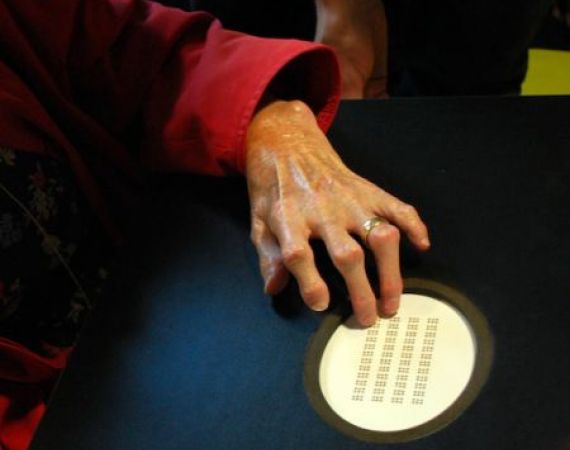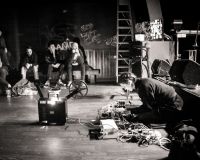Lunchtime talk write-up
Posted on Mon 19 Jan 2015
A few things I learnt from the Bristol Braille Lunchtime Talk
On 28 November, Ed Rogers and Steph Tyszka came to the Studio to talk about the recent decline in Braille literacy and their work developing affordable and accessible refreshable Braille devices. Here are a few of the key points I took away.A decline in Braille literacy - Braille is…

Elizabeth testing a prototype of Canute - Photograph by Nic Marshall
Posted by

Jasmine Butt
Jasmine is a musician, synth builder and AV artist who is currently exploring modular synthesis.On 28 November, Ed Rogers and Steph Tyszka came to the Studio to talk about the recent decline in Braille literacy and their work developing affordable and accessible refreshable Braille devices. Here are a few of the key points I took away.
A decline in Braille literacy - Braille is a tactile alphabet, and is as vital for literacy for the blind as printed word is for sighted people. Braille literacy accounts for a 50% increase in employment among the blind, yet it is taught and read less than ever before. Ed put this down to ‘four decades of technical stagnation’ in this area. Refreshable Braille devices were developed in the 1970s, but they cost a small fortune. 40 years on, we are seeing similar devices, which are only single-line and still cost thousands. The main methods of writing Braille consist of either using a typewriter designed in the 1950s, or punching it out by hand with a slate and stylus. As an alternative to Braille, text to speech can be useful, but it can also be quite intrusive, and it doesn’t work for reading and writing things like maths or music.
Bristol Braille – Bristol Braille is a not-for-profit organisation that is volunteer run by a group of designers, engineers and programmers. It was set up by Ed in 2008. After a chance meeting with Matt Venn in 2012 at Bristol Hackspace (where Bristol Braille is now based) the wider group began to form. The team have worked on a number of prototypes over the years, and are currently developing Canute, a multi-line refreshable Braille ebook reader, which they are co-designing with Braillists.
Braillists – Braillists is a network of Braille readers, which formed after a Canute user testing session last year. Braillists now has 60 members, and is currently spreading across different communities. The Braillist groups will advise on the design of the devices being developed by Bristol Braille, and will have first access to any of the resultant products or prototypes.
Openness is key – Ed and Steph told us a few of the reasons why they feel that being open is vital for sustaining the work of Bristol Braille. They want their project information to be available to those that need it the most. They have chosen to develop their products on small-scale batch manufacturing tools, using off the shelf components so that the project can be distributed to and made at maker spaces like the Hackspace. Ed pointed out that ‘If a closed project goes bankrupt, as far as the rest of the world is concerned, nothing happened. Being open source means that others can pick up where you left off.’ Ed and Steph told us that over the course of various Braillist user groups, they have learnt to be honest about their mistakes. ‘It is good to have an imperfect system, as it gives room for adaptation.’ The Braillists found solutions to many of the problems that the Bristol Braille team presented, and while discussing the prototype, they sometimes spotted extra uses for the device. While discussing whether Canute could be used in the kitchen to follow recipes, one of the Braillists mentioned that a rubbing could be made of the refreshable Braille. This was tested, and Canute now serves the purpose as a note embosser. Bristol Braille are taking this extra function into consideration while developing the next prototype. Ed and the team also want the Canute software to be editable by users, so they are developing it in such a way that it can be easily rewritten by those who would want to use it.
Midas – Bristol Braille are also developing wearable haptic Braille technology. Midas is a glove, which reads your movements and gives out small vibrations on different parts of the hand as you move it from left to right. The vibrations correspond to different letters of the Braille alphabet. This portable, IoT Braille device is an absolute first in this field, and Ed and the team are looking to launch it on Kickstarter this year.
Follow @Bristol_Braille to find out how their projects are developing.